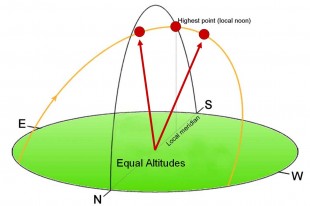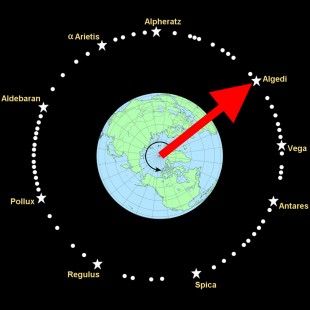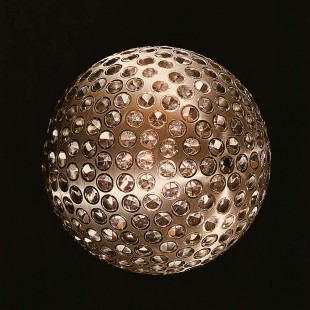…where east meets west
- Home
- Brief History
- The Greenwich Meridian
- Greenwich
(1675–1958) - Herstmonceux
(1948–1990) - Cambridge
(1990–1998) - Outstations (1822–1971)…
- – Chingford (1822–1924)
- – Deal
(1864–1927) - – Abinger
(1923–1957) - – Bristol & Bradford on Avon
(1939–1948) - – Bath
(1939–1949) - – Hartland
(1955–1967) - – Cape of Good Hope
(1959–1971)
- Administration…
- – Funding
- – Governance
- – Inventories
- – Pay
- – Regulations
- – Royal Warrants
- Contemporary Accounts
- People
- Publications
- Science
- Technology
- Telescopes
- Chronometers
- Clocks & Time
- Board of Longitude
- Libraries & Archives
- Visit
- Search
The astronomical basis of timekeeping
The purpose of this page is to provide background information about the different ways in which time has been determined since the Observatory’s founding in 1675. It covers basic astronomical principles, together with some of the many definitions of time that scientists use. It also refers to the specific instruments that were used at the Royal Observatory, together with some of the principles of their operation.
Besides the sundial, methods for determing the local time from observations of the sun or stars have been known since ancient times. Timekeepers are instruments that measures the passage of time. They need to be adjusted so that they go at the correct rate and reset periodically to show the correct time. Until the introduction of the pendulum clock in the latter half of the seventeenth century, timekeepers were unable to keep time to better than about 15 minutes a day. By contrast, the first pendulum clocks were able to keep time to about 10 seconds a day. By the mid twentieth century, this had been improved by a factor of 10,000, with the best clocks being able to keep time to around a few seconds a year. Today’s atomic clocks are capable of keeping time to better than one second in 1,400,000 years.
At Greenwich, time determinations were made from observations of the Sun until Edmond Halley obtained the Observatory’s first transit telescope in 1721. After that date, all time determinations were made from observations of the stars.
Timekeeper Earth
When the Royal Observatory was founded at Greenwich in 1675, it was generally believed that the Earth was spinning at a steady rate (or in technical speak, isochronous). Our day is based on the length of time it takes for the Earth to spin around once on its axis. Historically this was measured either by reference to the position of the Sun, or by reference to the positions of the stars. Each day is divided in 24 hours, each hour into 60 minutes and each minute into 60 seconds.
The Observatory was established with the specific and practical purpose of ‘rectifying the Tables of the Motions of the Heavens, and the places of the fixed Stars, so as to find out the so much desired Longitude of Places for perfecting the art of Navigation’. Since it was proposed to measure longitude differences by measuring time differences, it was important to establish at the outset if the Earth was indeed isochronous. To this end, Flamsteed set up the so-called Sirius Telescope in the Great Room (Octagon Room) of Flamsteed House. His observations confirmed not only the isochronal nature of the Earth, but also enabled him to determine how the length of the solar day varied with the seasons (more about this in the next section).
The development of new types of clock in the mid twentieth century led to the discovery of small variations in the rate at which the Earth is turning. The subsequent development of atomic clocks which were more accurate still, led to a fundamental change in the way that the second is defined. More about this later.
Different sorts of time
One of the oldest ways of finding the time is with a sundial. The further west you are, the later the Sun rises and the later it sets. When a sundial in Greenwich is showing 9.00 a.m., one to its west in Cardiff will show 8.47 a.m. The time indicated by a sundial is called the ‘local apparent time’.
The local meridian is an imaginary line connecting the north and south poles which passes though the observer’s position. The time when the Sun transits (crosses over) the local meridian is called the ‘local noon’.
The interval between successive transits of the Sun is about four minutes longer than the interval between similar transits of other stars. This is because at the same time that the Earth is spinning on its axis, it is also orbiting the Sun, progressing about 1° around its orbit with each complete turn. Between one transit of the Sun and the next, the Earth therefore has to turn through an angle of about 361° rather than the 360° required for the other stars – thereby accounting for the extra 4 minutes. Time measured by the stars is called sidereal time. Time measured by the Sun is called solar time.
In practice, the length of each day measured from one local noon to the next varies in a periodic manner throughout the year. The longest is about 51 seconds longer than the shortest. The difference arises partly as a result of the Earth’s orbit being elliptical rather than circular and partly as a result of it being tilted on its axis. Each day measured by a clock has the same length and is equal to the average or mean length of a solar day. This is where the word ‘mean’ in ‘mean time’ comes from. When solar days are shorter than average, a clock will seem to loose time compared to a sundial. When they are longer, it will appear to gain.
Greenwich Mean Time (GMT) is the local Mean Time at Greenwich. Today it is reckoned from one midnight to the next, but until 1925 was also reckoned for astronomical purposes from one midday to the next (the astronomical day), giving an ambiguity to its meaning. Greenwich Mean Time is 13 minutes ahead of Cardiff Mean Time (the local mean time in Cardiff) and 10 minutes ahead of Bristol Mean Time. Until the coming of the railways, clocks in most towns and cities were set to show local mean time. In order to make their timetables less confusing, railway companies began introducing a single standard time across their networks. In mainland Britain, it was Greenwich Mean Time that was normally adopted. By 1855, 98% of the public clocks in Great Britain were set to show Greenwich Mean Time. Greenwich Mean Time became the legal Time of Great Britain in 1880. Nowadays, everybody within a country or time zone sets their clocks and watches to the same time for civil purposes.
Like solar days, sidereal days also very slightly in length from one day to the next. The variation in the length of the sidereal day was too small to be sensibly measured until the introduction of the Shortt free-pendulum Clocks in the 1920s which set a new standard in precision timekeeping. As a result, Astronomers began to refer to a new unit of time – the mean sidereal day.
Determining time from the Sun by the Double Altitude Method
When the Observatory was founded, the normal method of time finding was by the Double Altitude or Equal Altitude Method. Unlike a star (which even through a telescope is seen only as a point of light), it is very difficult because of its size, to determine the precise moment at which the Sun crosses the meridian. Because of this, astronomers took an altitude observation of the Sun an hour or so before noon as its altitude was increasing, recording the time at which the observation was made. They then took a second observation, in the afternoon as the sun moved lower in the sky, recording the time when the sun reached the same altitude as it had had when the first observation was made. With a small correction to allow for the change in the Sun’s declination, the time halfway between the two equal altitude observations was the time of apparent noon, from which mean noon was calculated and the error of the clock determined. At Greenwich, the observations were made in the Octagon Room with the aid of a moveable quadrant on a vertical axis, the clock being one of those made by Thomas Tompion and supplied to Flamsteed by Jonas Moore at the time of the Observatory’s founding. The observations made were probably accurate to about five seconds of time.In his book Greenwich Time (1980 & 1997), Howse states that this was 'the principle method used at Greenwich from 1676 to 1725'. Whether of not this was really the case needs further research as Howse quotes no sources.
We can be certain that Flamsteed did use the method in the early days as in a letter to Towneley on 3 November 1677 he wrote that rather than use a long meridian line (which was difficult to lay out):
'I rather choose to Confide in my Quadrant by which I find I can take altitudes certainly to 1 minutes exactnesse. and by takeing the suns heights or any *s that has north declination when it is in equall altitude on both sides of the Meridian and some 3 or 4 hours distant from it I can find the error of the clock with as little calculation almost as you can from the suns transits over your meridian line ...'
In later years, when the way in which the Earth moves around the Sun was better understood, a single altitude observation may have been sufficient though errors would have arisen unless atmospheric refraction was taken into account. As the phenomenon was poorly understood in Flamsteed's time, it seems probable that he would have avoided the method and stuck with the equal altitude method since it was reasonable to assume that the amount of refraction would have been about the same for both observations and that no significant correction was therefore required – unless that is, the atmospheric conditions had changed significantly in the interval between the observations (in which case, Flamsteed would probably have abandoned the observations as unreliable).
One way of checking if Flamsteed really did use the equal altitude method in later years would be to find the observations themselves. The catalogue of his papers at Cambridge however makes no specific reference to them suggesting that Flamsteed did not systematically record all such observations together. One example of the method in use can be seen in the published observations made on 27 June 1684. What is clear from these and other similar sets of observations, is it that the second observation was made only at approximately the same altitude.
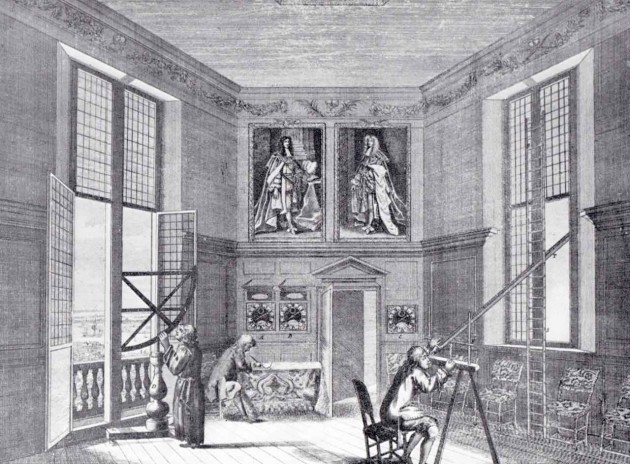
The Octagon Room at the Royal Observatory in the 1670s. The Tompion clocks can be seen in the centre. The quadrant on the left is shown looking northwards. It could be wheeled from window to window and was probably the one used by Flamsteed for his equal altitude measurements. Engraving by Francis Place after Robert Thacker c.1676, republished in The Old Royal Observatory (HMSO, 1960)
Determining time from the stars with a transit instrument (used at the Observatory from 1721–1955)
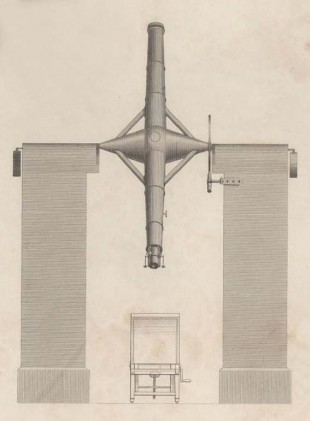
The Troughton 10-foot Transit Instrument. Drawn by J Farey and engraved by T Bradley. Plate 16 (adapted detail) from Pearson's An introduction to practical astronomy (London, 1829). Image courtesy of Robert B. Ariail Collection of Historical Astronomy, Irvin Department of Rare Books and Special Collections, University of South Carolina Libraries
During the Second World War, the Greenwich Time Service operated mainly from Abinger in Surrey. To allow for the fact that Abinger is to the west of Greenwich, all time determinations made there were adjusted to allow for its difference in longitude. Similar adjustments were made following the Observatory’s move to Herstmonceux.
The list below details the various transit instruments used for time determination at the Observatory together with their date of use and the site on which they were operated:
- Halley’s 5-foot Transit Instrument (Greenwich, 1721–1750)
- Bradley’s 8-foot Transit Instrument (Greenwich, 1750–1816)
- Troughton 10-foot Transit Instrument (Greenwich, 1816–1850)
- Airy’s Transit Circle (Greenwich, 1850–1927)
- Bamberg Broken Transit (Abinger, 1940s & 50s)
Aligning a transit instrument to the meridian
The Greenwich instruments like those in other observatories around the world, were aligned to the meridian by making observations of the circumpolar stars – stars that never rise nor set.
These stars are always present in the sky and transit the meridian twice rather than once each day. When the telescope is correctly aligned, the measured interval between successive transits of any particular circumpolar star is constant.
If a good catalogue was to hand, the right ascensions of a high and a low star could be used instead. Once a transit telescope had been adjusted to the meridian, it was possible to create a mark on the horizon for use as a quick alignment check.
The standard way of checking the collimation (alignment of the optics) of a transit telescope prior to the introduction of collimators in the 19th century was to adjust the telescope to a distant point or mark on the horizon and then reverse it in its mountings. Other things being equal, if the optics were correctly aligned, the mark would still be seen in the centre of the field of view. Reversing the telescope was a time consuming and a potentially hazardous operation. Once a transit telescope had been initially collimated; provided correctly placed meridian marks were available to both the north and the south, there was no further need to reverse the telescope unless, when aligned to one mark, it was out of alignment with the other. By then reversing the telescope, it was possible to determine if the problem was one of collimation or a shifting of one or other of the marks. A further way of checking the collimation independently of any mark (and one occasionally used by Maskelyne) was to reverse the telescope during the passage of Polaris.
There were a variety of factors relating to the setting up, use and maintenance of the marks at Greenwich which the Astronomers Royal had to consider and contend with. These included:
- Local topography – which affected the choice of locations, particularly to the south
- Availability of suitable sites
- Stability – including subsidence or marks becoming loose
- Accessibility – especially if the mark was on the chimney or wall of a private building or some distance from Greenwich
- Visibility – which could be seriously impaired by moored boats on the Thames, trees and atmospheric pollution, to say nothing of the mists that rolled in over the Greenwich marshes
- Errors emanating from the design or manufacture of the telescopes, or the observing procedures adopted.
Errors associated with Transit Instruments
The following discussion of the instrumental errors associated with Transit Instruments is taken from a lecture titled The Determination of Precise Time, which was given by the Astronomer Royal, Harold Spencer Jones in 1949:
‘The pivots rest in fixed bearings, adjusted so that the common axis of the pivots is as nearly as possible horizontal and pointing in an east-west direction. If the axis of the pivots were exactly horizontal and in the east-west direction and if the optical and mechanical axes of the telescope coincided, the axis of the telescope would be in the meridian plane, whatever direction the telescope was pointing to. This ideal condition is never achieved and there are always small errors of level, of azimuth, and of collimation. These adjustments are liable to continual change; there are slow seasonal changes, associated with changes of temperature and possibly also with subsurface moisture; there are also more rapid changes, which are correlated with changes of circumambient temperature and with the direction of the wind. To control these changes frequent observations of level, of azimuth, and of collimation are essential, which take up a disproportionate amount of the observing time. The error of collimation can, however, be eliminated if the telescope is reversed in its bearings in the middle of each transit, half the transit being observed before reversal and the other half after reversal. It is not possible to reverse large transit instruments sufficiently quickly and it has accordingly become customary to use small transit instruments, which can be rapidly reversed, for the determination of time; as it is the brighter stars which are observed, a large aperture is not needed.
There are other factors which have also to be taken into consideration. The pivots will never be absolutely cylindrical; their figures have to be determined with great accuracy and appropriate corrections made to the observations. Flexure of the axis can cause troublesome systematic errors. If the horizontal axis is not equally stiff in all directions, its flexure will vary according to the direction in which the telescope is pointed. If the two halves are not equally stiff, the telescope will be twisted from the meridian by a variable amount. Personal equations between different observers are somewhat troublesome, though they do not exceed a few hundredths of a second when the so-called impersonal micrometer is used. Before its introduction, the method of observing was for the observer to press a hand-tapper at the instant the star crossed each of a number of vertical spider wires in the focal plane of the telescope; by so doing, he closed an electric circuit which sent a current to a recording chronograph, which recorded not only the signals from the telescope but also time signals, every second or alternate seconds, from the clock. The instants of the star crossing the wires could then be read off at leisure after the observations had been completed. With this method of observing, the times determined by different observers could differ by as much as half a second. The reason is easy to see; one observer might wait until he saw the star actually bisected by the wire before he pressed the tapper, with the result that, because of the time required for the message to travel from his brain to his eye and to be converted into muscular action, his signal would inevitably be late; another observer would, as it were, shoot the flying bird, gauging the rate of motion of the star so that his tap is made as nearly as possible at the instant at which the star is actually bisected. The personal equations can be determined by what are called personal equation machines; the transit of an artificial star is observed, the times at which the star is at certain positions during the transit being compared with the observed times. Although an observer will unconsciously form a fixed habit in observing so that his personal equation remains substantially constant, small variations, depending upon the physical condition of the observer, do occur.
The method of observing now almost universally employed is to have a single movable wire in the micrometer eyepiece instead of a number of fixed wires. The wire can be traveled along by the observer, who adjusts its speed so as to keep the star continually bisected by the wire. As the wire moves along, contacts are automatically made in certain positions, sending signals which are recorded on the chronograph. In order to relieve the observer of some of the strain of maintaining a uniform motion of the wire, it is now common to drive the wire mechanically at the speed appropriate to the motion of the star, using an electric motor with some form of continuously variable gearing. With this method of observing, the personal equations of different observers are very small, usually not more than two or three hundredths of a second; it is for this reason that this form of micrometer is called the “impersonal” micrometer. Small though these residual personal equations are, they remain remarkably constant and can be determined by personal equation machines. They seem to arise from two causes: there is “bisection error,” an observer systematically bisecting an image to the right or to the left of its center; this error changes sign at the zenith with instruments in which the observer changes the direction in which he faces, according to whether he is observing a north or a south star; there is also “following error,” an observer systematically setting the wire in front of or behind the center of a moving image. This error does not change sign at the zenith.
If the pivots are not exactly cylindrical, the telescope will be twisted out of the meridian by an amount varying with its position. The figures of the pivots must therefore be determined with great accuracy and appropriate corrections applied to the observed times of transit. The figures of the pivots must be determined at intervals, as they may change slowly in the course of use through wear. Other variable errors can be introduced through slight mechanical imperfections in the telescope; if there is the slightest play in the eyepiece micrometer or in the objective, errors will be introduced which will vary with the position of the telescope.
When all the possible sources of error which can affect observations with a transit instrument are borne in mind, it is rather surprising that the observations are as accurate as they are. The probable error of a single time determination is usually about two-hundredths of a second.’
Determining time with a photographic zenith tube (used at Herstmonceux from 1955–1984)
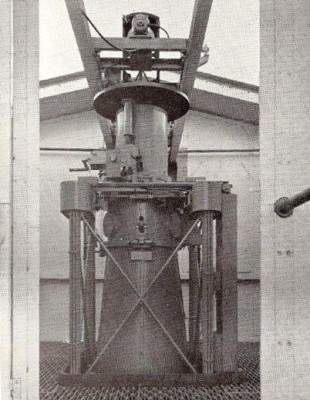
The Photographic Zenith Tube. From an RGO photo published in 1959. Image courtesy of Phillip Gething
Determining time with a Danjon Prismatic Astrolabe (used at Herstmonceux in 1962–3)
The Danjon Prismatic Astrolabe is a highly specialist instrument developed in the 1950s by the French astronomer André-Louis Danjon as a replacement for the transit instrument which was considered to have reached its technological design limit. Danjon Astrolabe OPL. No. 9 was brought into service at the Royal Greenwich Observatory, Herstmonceux in July 1959, primarily to extend the study of its effectiveness in determining catalogue corrections which had been carried out elsewhere. It could however also be used for time determinations and between July 1962 and 1963, was used to provided data for the Greenwich Time and Latitude Service while the Photographic Zenith Tube was out of service for investigation and overhaul.
The International Meridian Conference of 1884 and the creation of Universal Time (UT)
Although latitude has always been measured from the Equator, there is no equivalent point from which to measure longitude. Over the years, it has been measured from many different places, including national observatories, the island of Hierro in the Canaries and St Paul’s Cathedral in London – each country having chosen for itself where to measure from.
The introduction of the Nautical Almanac in 1767 had required sailors to make use of astronomical time, where the day was reckoned from noon, beginning twelve hours after the start of the civil day. Until then, sailors had used the civil day along with the nautical day. The nautical day also began at noon, but started twelve hours earlier than the civil day. The potential for confusion because of the similarity between astronomical and nautical days was much reduced when on 11 October 1805; the British Admiralty issued an order to end the use of the nautical day. A similar change was made in America in 1848.
The start of the nineteenth saw calls for unification and the adoption of a single common meridian. But the problem was not one of geographical location alone; it was also linked to the measurement of time. To rationalise one, would require the rationalisation of the other. After much preparation of the ground, an International Meridian conference took place in October 1884 in Washington DC. Attended by 41 delegates from 25 nations, if passed a total of seven resolutions:
- That it is the opinion of this Congress that it is desirable to adopt a single prime meridian for all nations, in place of the multiplicity of initial meridians which now exist.
- That the Conference proposes to the Governments here represented the adoption of the meridian passing through the centre of the transit instrument at the Observatory of Greenwich as the initial meridian for longitude.
- That from this meridian longitude shall be counted in two directions up to 180 degrees, east longitude being plus and west longitude minus.
- That the Conference proposes the adoption of a universal day for all purposes for which it may be found convenient, and which shall not interfere with the use of local or other standard time where desirable.
- That this universal day is to be a mean solar day; is to begin for all the world at the moment of mean midnight of the initial meridian, coinciding with the beginning of the civil day and date of that meridian; and is to be counted from zero up to twenty-four hours.
- That the Conference expresses the hope that as soon as may be practicable the astronomical and nautical days will be arranged everywhere to begin at mean midnight.
- That the Conference expresses the hope that the technical studies designed to regulate and extend the application of the decimal system to the division of angular space and of time shall be resumed, so as to permit the extension of this application to all cases in which it presents real advantages.
The resolutions from the conference were only proposals – it was up to the respective governments to show political will and implement them ... and progress was slow ... very slow. Resolution six was particularly problematic – not because of the nautical day (which had been dealt with before and was easy to change), but because of the implications of changing the astronomical day. Changing it would take a great deal of coordination if confusion and misunderstandings were to be avoided as Samuel Franklin the man in charge of the Naval Observatory in the United States was soon to discover. The order he issued on 4 December 1884 for the changes to be introduced from 1 January had to be rapidly rescinded, following his failure to properly anticipate the practical implications of so sudden a change. William Christie his opposite number at Greenwich was rather more circumspect. He made only a symbolic gesture, which included altering the Observatory’s public clock with its 24-hour dial. From 1 January 1885, instead of showing astronomical time as it had in the past, it was set to show civil time – a change that involved moving the hour hand half way around the dial.
The end of the astronomical day was effectively sealed in 1918, when the Council of the Royal Astronomical Society reported in favour of change, recommending that Universal Time should be introduced into the Nautical Almanac with effect from 1 January 1925.
What the International Meridian Conference did not do was recommend a global system of time zones. Our system of time zones emerged largely by default as one by one different countries chose to adopt a standard time based not on their capital city or national observatory, but one that was generally a whole number of hours ahead or behind Universal Time.
Click here to read more about the build up to the International Meridian Confence and how its resolutions were enacted.
Redefining the second in the 1950s and 60s
Although long term and irregular variations in the speed of the Earth had been suspected from the eighteenth century onwards, it was not until the advent of better time keepers in the form of the Shortt free-pendulum clock together with the subsequent analysis of the observed motions of the Sun, Moon and planets which was published by Spencer Jones in 1939, that the necessity for a new astronomical timescale independent of the rotation of the Earth became evident.
Discussions about its introduction began in the late 1940s, with a new definition being adopted by the General Assembly of the International Astronomical Union (IAU) in Rome in 1952. Instead of being defined as 1/86,400 of a mean solar day as it had been the case in the past, the second was now defined as a fraction of a year. But because years, like days, also vary in length, the specific year of 1900 was chosen. Various names for the new timescale were considered including ‘Newtonian time’ and ‘uniform time’ time but in the end, the name which ended up being adopted was ‘ephemeris time’.
Following further discussion, it was deemed desirable to tweak the new definition of the second, and change the type of year referred to from the sidereal year (which is measured by reference to the stars) to the tropical year (which is measured with reference to the seasons and is around 6 minutes shorter). The change from sidereal year to tropical year was adopted by the IAU in 1955. In science speak; the second was now defined as 1/31,556,925.975 of the tropical year for 1900.0. In 1956, this value was adjusted to 1/31,556,925.9747 of the tropical year for 1900 January 0 at12 hours ephemeris time. This definition was enshrined in the new system of International System of Units (SI) that formally came into being in 1960. As such, it became the definition used by everyone rather than just astronomers.
Although the new definition had the great advantage that the length of the second was no longer prone to vary slightly form one day to the next, it had the great disadvantage that it was rooted in the past and as a result was a very difficult standard with which to make comparisons.
Meanwhile, back at the National Physical Laboratory in Teddington in London, Louis Essen had developed a new type of clock that worked using microwave radiation and the properties of the caesium 133 atom. Referred to as atomic clock, it set a new standard in timekeeping; proving more stable than the quartz clocks which had been developed in the 1930s and 40s. More importantly, it proved to be a more stable timekeeper than the Earth. Atomic time also had an important practical advantage over ephemeris time, in that it was easily obtainable for comparative purposes. As a result a new definition for the second was drawn up whose value was equal to the observationally determined value of the ephemeris second. The new definition was formally adopted as part of the SI system at the Thirteenth General Conference on Weights and Measures in October 1967. Since that date, the second has been defined as ‘the duration of 9,192,631,770 periods of the radiation corresponding to the transition between the two hyperfine levels of the ground state of the atom of caesium133’. Although the atomic timescale is now the norm, the later derivatives of ephemeris time are still of importance to astronomers.
Our slowing Earth and the introduction of Coordinated Universal Time (UTC)
With the Earth gradually slowing, but the new atomic timescale not slowing with it, the position of the Sun in the sky was set to get more and more out of step with the time it represented. The idea of 12 noon gradually shifting into the morning and then into the night was not something that most people wanted to contemplate – even if it was going to take tens of thousands of years to become significant.
The problem was solved in 1972, with the introduction of an adjusted atomic time scale, Coordinated Universal Time (UTC). The rotation of the Earth is monitored by various organisations around the world, the data having been coordinated since 1987 by the the International Earth Rotation Service (IERS) in Paris and then the International Earth Rotation and Reference Systems Service (IERS) after it was renamed in 2005. Every now and again, (historically at the end of either June or December with an announcement being made by the IERS roughly six months earlier), an extra second known as a leap second, is introduced to keep UTC within 0.9 seconds of GMT. Although UTC has no legal status in the UK, it is this rather than Greenwich Mean Time which is used in practice.
In recent years, there has been a push by some scientists to have UTC abolished as it is said to create difficulties, especially in computing. Click here to read more.
Satellite Laser Ranging
Satellite Laser Ranging (SLR) originated in the United States of America in 1964. By measuring the journey time for a pulse of laser light to travel to and from a satellite carrying a retro-reflector, the distance to the satellite at any moment in time can be determined. By combining observations from base stations around the world, variations in the Earth’s rate of rotation can be deduced, along with other important scientific data such as tectonic plate movements.The satellites which are tracked, orbit the Earth at heights between 400 and 20,000 km. They fall into four main groups: geodetic, gravitational, altimetry and navigation. The Lageos satellites are an example of a geodetic satellite – the name being an abridgement of Laser Geodynamic. They look like giant golf balls. They are made of aluminium-covered brass and are fitted with numerous retro-reflectors. They have a diameter of 60 cm, a mass of 411 Kg and are in highly stable and predictable orbits at an altitude of 5,900 Km.
The Royal Observatory first became involved with Satellite Laser Ranging in the early 1970s. A facility for Herstmonceux was approved by the Science Research Council’s Astronomy, Space and Radio (ASR) Board in July 1978, with funding being approved by the Science Reserch Council (SRC) on 27 November 1979 and subsequently by the Department of Education and Science (to whom the SRC were answerable). By September 1980, the general design had been completed and most of the equipment ordered. The planning and preparatory work was carried out in collaboration with the University of Hull, which was responsible for the design assembly and testing of the laser, detection and timing subsystems
The facility was located in the by then redundant Solar Building. A 50-cm Cassegrain receiving telescope was installed on 3 July 1981 and the laser in April 1982. The first return signals were detected at the end of March 1983, with the system becoming fully operational by October the same year. A contribution towards the running costs was made by the Department of Trade and Industry (DTI), the Ministry of Defence (MoD) and Natural Environment Research Council (NERC).
A military radar on loan from RSRE Malvern was mounted on the roof of the control room to detect any aircraft that might fly into the laser beam, necessitating a temporary shutdown of the laser in order to prevent anyone looking into the beam and being blinded. An additional visual watch was kept for low flying aircraft and gliders.
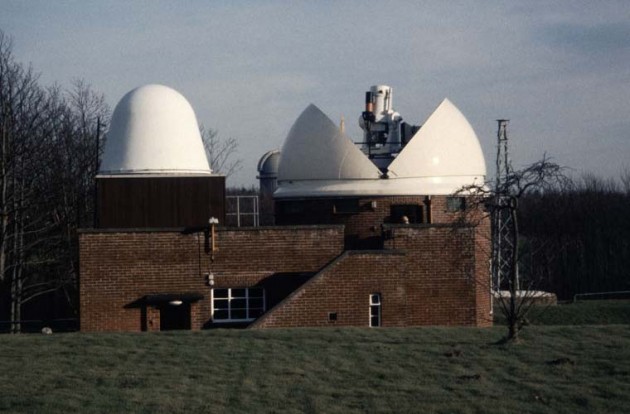
The Satellite Laser Ranger facility at Herstmonceux in the 1980s. The dome on the left contains the radar equipment and that on the right the receiving telescope. Mounted on the left side of the receiving telescope is a smaller telescope through which the laser beam is emitted. Photo courtesy of Patrick Moore
The Ordnance Survey placed a trigonometric pillar (solar) near the building and linked it trigonometrically to the pillar (Herstmonceux) near the Isaac Newton Telescope dome so that the UK network could be linked accurately to the international network.
When the Observatory vacated the site at Herstmonceux in 1990, this one facility was retained, a small hut being built alongside to provide office accommodation to replace that lost in the West Block, which was sold with the Castle. When the RGO was shut down completely in 1998, the facility was taken over by NERC (Natural Environment Research Council). In April 2013, it became part of Earth Hazards and Observatories research theme under the management of the British Geological Survey (BGS). Its purpose remains much the same as before, the data it gathers being used together with that from other institutions to inform the decisions made by IERS on the introduction of the next leap second. Click here to read about the current facility and find out about the satellites being tracked today.
Further reading
Lectures and articles by the Astronomer Royal. Harold Spencer Jones
The Earth As A Clock, being the Halley Lecture delivered on 5th June 1939. Published by Oxford University Press, 1939
The Determination of Precise Time. Sixteenth Arthur lecture, given under the auspices of the Smithsonian Institution April 14, 1949
Royal Greenwich Observatory. August 15, 1949, Proc. R. Soc. Lond. A 198:141-169. Click here to download from the British Geological Survey website (pdf file)
Discussions
Modern Methods of Timekeeping. Record of a discussion held at the Royal Astronomical Society on 21 March 1947. Amongst those taking part were the Astronomer Royal and Louis Essen. The Observatory, Vol. 67, p. 132-136 (1947)
Lectures given by Donald Sadler, Superintendent of HM Nautical Almanac.
Astronomical Measure of Time, being the Presidential Address of the Royal Astronomical Society given at the anniversary meeting on 9 February 1968. Quarterly Journal of the Royal Astronomical Society, Vol. 9, p.281
Account in the Explanatory Supplement to the Astronomical Ephemeris and the American Ephemeris and Nautical Almanac, (HMSO London, 1961)
This volume, which was reprinted with amendments in 1972, 1974, and 1977, has a chapter on Systems of Time Measurement. Click here for a history of the volume and its later editions.
© 2014 – 2026 Graham Dolan
Except where indicated, all text and images are the copyright of Graham Dolan
